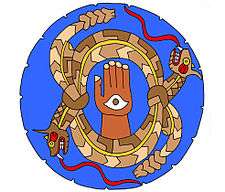Creek mythology
Creek mythology is related to a Creek Native American tribe who are originally from the southeastern United States, also known by their original name Muscogee (or Muskogee), the name they use to identify themselves today.[1] Mvskoke is their name in traditional spelling. Modern Muscogees live primarily in Oklahoma, Alabama, Georgia, and Florida. Their language, Mvskoke, is a member of the Creek branch of the Muskogean language family. The Seminole are close kin to the Muscogee and speak a Creek language as well. The Creeks were considered one of the Five Civilized Tribes. After the Creek War many of the Creeks escaped to Florida to create the Seminole.
History

The early historic Creeks were probably descendants of the Mississippian culture peoples who lived along the Tennessee River, in what is now modern Tennessee[2] and Alabama, and possibly related to the Utinahica of southern Georgia. More of a loose confederacy than a single tribe, the Muscogee lived in autonomous villages in river valleys throughout what are today the states of Tennessee, Georgia, and Alabama also consisted of many ethnic groups speaking several distinct languages, such as the Hitchiti, Alabama, and Coushatta. Those who lived along the Ocmulgee River and the Oconee River were called "Creek Indians" by British traders from South Carolina; eventually the name was applied to all of the various natives of Creek towns becoming increasingly divided between the Lower Towns of the Georgia frontier on the Chattahoochee River, Ocmulgee River, and Flint River and the Upper Towns of the Alabama River Valley.
The Lower Towns included Coweta, Cusseta (Kasihta, Cofitachequi), Upper Chehaw (Chiaha), Hitchiti, Oconee, Ocmulgee, Okawaigi, Apalachee, Yamasee (Altamaha), Ocfuskee, Sawokli, and Tamali. The Upper Towns included Tuckabatchee, Abihka, Coosa (Kusa; the dominant people of East Tennessee and North Georgia during the Spanish explorations), Itawa (original inhabitants of the Etowah Indian Mounds), Hothliwahi (Ullibahali), Hilibi, Eufaula, Wakokai, Atasi, Alibamu, Coushatta (Koasati; they had absorbed the Kaski/Casqui and the Tali), and Tuskegee ("Napochi" in the de Luna chronicles).
Cusseta (Kasihta) and Coweta are the two principal towns of the Creek Nation to this day. Traditionally the Cusseta and Coweta bands are considered to the earliest members of the Creek Nation.[1]
Creation

The Creek believe that the world was originally entirely underwater. The only land was a hill, called Nunne Chaha, and on the hill was a house, wherein lived Esaugetuh Emissee ("master of breath"). He created humanity from the clay on the hill.
The Creek also venerated the Horned Serpent Sint Holo, who appeared to suitably wise young men.
In the underworld, there was only chaos and odd creatures. Master of Breath created Brother Moon and Sister Sun, as well as the four directions to hold up the world.
The first people were the offspring of Sister Sun and the Horned Serpent. These first two Creeks were Lucky Hunter and Corn Woman, denoting their respective roles in Creek Society.
Hisagita-imisi (meaning "preserver of breath"; also Hisakitaimisi) was the supreme god, a solar deity. He is also called Ibofanga ("the one who is sitting above (us)").
References
- 1 2 Transcribed documents Sequoyah Research Center and the American Native Press Archives
- ↑ Finger, John R. (2001). Tennessee Frontiers: Three Regions in Transition. Indiana University Press. p. 19. ISBN 0-253-33985-5.
See also
| ||||||||||||||||||||||||||||||